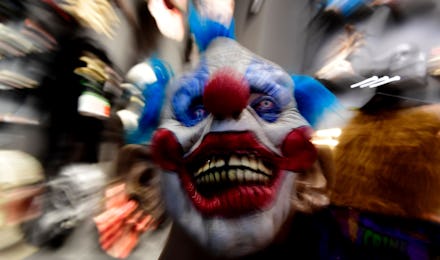Creepy clown sightings are back — here’s why experts say they’re so scary

No one sent for these clowns, and yet here they are. Again.
Creepy clown hysteria plagued the U.S. over the summer and fall of 2016, when people in scary makeup and masks terrorized locals in cities and towns across the country. Now the spooky phenomenon appears to be happening again, with a string of clown sightings making headlines in recent weeks.
A Montana man wearing clown makeup was questioned by local police on Sunday after witnesses reported him for allegedly throwing fireworks into traffic as he walked along a local highway, according to Daily Inter Lake.
On Saturday, a man dressed as a clown in Wilkes-Barre, Pennsylvania, reportedly used cash to try luring a 9-year-old girl into following him, according to the Associated Press.
A local CBS affiliate in Boston reported an axe-wielding Insane Clown Posse fan’s July 10 arrest in Medford, Massachusetts, after a three-hour standoff with police in the parking lot of the local Kiss 108 radio station. Authorities there dodged an axe throw from the 38-year-old suspect, who traveled to the station to demand that someone play ICP’s “My Axe” on the airwaves.
On July 2, two knife-wielding men — one dressed in clown attire — spooked two young girls as they played outside in Madison, Wisconsin, prompting nearby adults to call police, the Wisconsin State Journal reported.
Another creepy clown with a knife was spotted in Fargo, North Dakota, on April 29 — one of two men witnesses say approached a group of children, asking them if they “wanted to see a dead body.”
It’s enough to make Frank McAndrew, a Knox College professor of psychology and self-described “expert on creepiness,” suspect a connection to last year’s spate of clown sightings.
“I think there’s a copy-cat thing that goes on,” he said in a phone interview Monday.
The renewed surge of creepy clowns — not to mention the soon-to-be-released film remake of It — begs the question: Why are we so afraid of clowns, anyway?
Why are people so afraid of clowns?
McAndrew’s 2016 study on the world’s creepiest occupations got him in hot water with some members of the clown community. The study’s participants ranked clowns as the No. 1 creepiest job — over taxidermists and even undertakers.
“Clowns are kind of designed to creep you out,” McAndrew said. “They have all these unusual characteristics — the big hair, big nose, big shoes, baggy clothes. They usually have makeup on. You can’t really tell what their emotions are.”
According to McAndrew, part of the fear associated with clowns comes from natural triggers they can set off in the human psyche. Clowns often wear bright colors that in the animal kingdom are used to warn potential predators of dangerous elements like poison and venom.
Clowns also have exaggerated features and clothes that make them look larger than normal human beings and they commonly break with conventional interactive normative behavior.
“We like people to be predictable,” McAndrew explained. “There’s certain things you do in conversation, that show you understand the rules of civilized discourse. When somebody doesn’t follow those rules — they’re doing all these weird things, laughing at the wrong times — this makes them unpredictable. Clowns turn up the volume on all that stuff. They don’t follow the rules at all.”
For Christopher Bayes, a theater clown expert who teaches at the Yale School of Drama, modern American pop culture is largely to blame for clown phobias.
Serial killer John Wayne Gacy made the idea of a killer clown famous in the 1970s. Reports of Gacy sexually assaulting and fatally strangling teen boys while dressed as his kids’ birthday party alter ego, Pogo the Clown, made Gacy’s six-year, panic-inducing spree of 33 murders all the more terrifying.
Stephen King’s novel It was published less than a decade later, which Bayes said unfairly raised the bar on clown-related horror.
“You can kind of blame it on Stephen King a little bit,” Bayes said. “The image of the clown has been co-opted by corporations over time.”
According to Bayes, versions of the clown can be found in pretty much every culture around the world — a character used to entertain and make fun of ruling figures in Europe, Asia and even in Native American cultures.
“It’s the funny guy who wants to make fun of the guy in charge,” Bayes explained. “Real clowns are beautifully naive, very open and playful.”